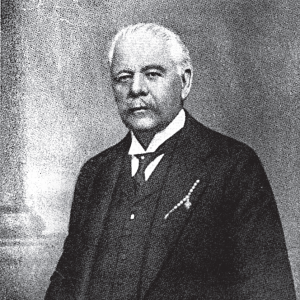William Henry McGarvey (1843–1914) – oil magnate from Canada

Pioneer from Quebec
William McGarvey was born in Huntingdon, Quebec, in 1843, and died in Vienna in 1914. From his early years he was accustomed to cash flow. His first contact with business was brought to him by a job at his parents’ store in Wyoming. The breakthrough event for both McGarvey and Canada was the discovery of oil deposits in Petrolia and Oil Springs in 1866. A resourceful youth decided to complete a drilling apprenticeship, and then quickly opened his own business dealing with the extraction of the new raw material. As a pioneer of oil industry, he also took care of a good image and influence on local politics – for a few years he was the mayor of the city of Petrolia and the governor of the Lambton County.
Conquest of Europe
In 1881 he decided to travel to Europe, where, being the head of Continental Oil Company, he began drilling in Hannover. Despite the usage of the then innovative drilling technique – henceforth called Canadian – the results of the work were negligible. Fortunately, the entrepreneur’s wife – Helena Jane Wesolowski, granddaughter of a Kosciuszko insurgent – drew her husband’s attention to the oil fields in Galicia.
At the time, McGarvey established a drilling company with a London banker, John S. Bergheim, and in 1884 he started drilling in Słoboda Rungurska, Uherce, Berehy Dolne near Ustrzyki and in Płowce. McGarvey’s technique, guaranteeing faster and deeper drilling, turned out to be perfect for the Subcarpathian substrate. Despite careful protection surrounding the secrets associated with it, a local constructor, Felicjan Łodziński, created his own, improved version of the Canadian rig.
Business shark
In the 80s and 90s of the 19th century, McGarvey was a shareholder of many Galician companies which opened new shafts. His name is associated with such successes in oil exploration as Libusza, Kobylanka, Siary, Sękowa, Szymbark, Ropica Ruska, Wietrzno, Równe and Potok. His investments significantly influenced the development of Galician oil industry.
In 1887, however, he decided to expand the scope of his ‘services’. In Glinik Mariampolski he founded not only the most modern refinery at that time, but above all the famous factory of drilling machines and tools, which developed dynamically – it opened more large branches in Boryslav, Tustanowice and Vienna.
Over time, he transformed his company into a recognizable brand under the name Galicyjsko-Karpackie Towarzystwo Naftowe (Galician-Carpathian Petroleum Association). After the discovery of very rich deposits in Eastern Galicia – in Drohobych, Boryslav and Tustanowice – the Canadian’s company expanded its operations into this region. Over time, it controlled as much as 25 percent of Galician oil extraction. The money made, experience and renown enabled McGarvey to get in touch with representatives of German capital with whom he created an oil syndicate. After 1905, he permanently moved to Vienna, from where he could control his ever-expanding oil empire.
A record holder and a tough business player
McGarvey liked breaking new limitations, breaking records. He was the first one to cross the barrier of 1000 meters of shaft depth – he attained this feat in 1902 in Boryslav. His activity contributed to the fact that Galicja became an exporter of petroleum products. His power may be demonstrated by opposition, or even blackmail, by the Vienna government regarding the construction of large tanks in Boryslav and the refinery in Drohobycz. This largest Galician refinery was opened in 1909. At first, the authorities did not agree to its opening, because they still wanted to make Galician oilmen dependent on Austrian processing – Viennese producers of petroleum products.
Citizen of Glinik Mariampolski
McGarvey did not neglect social work either. He was aware of the importance of developing social support for his employees. He financed the construction of a school and a nursery in Glinik, where he resided at that time. In 1894, he donated free land for building a school, complete with a garden and housing for a teacher in Glinik and supported its formation. Although he was a Protestant, he also founded a chapel for 200 believers. The nursery financed by him was run by the Nuns Servants of Immaculate Conception from Stara Wieś. The nuns concluded a contract with the Galician Carpathian Oil Stock Society (formerly Bergheim & McGarvey) under which they undertook to take care of children aged 3 to 6 years and to teach handicraft to older girls, while McGarvey’s company had to provide a brick house for the Nuns, as well as annual salary of 1000 crowns and fixed amounts of fuel, lighting and food. McGarvey also contributed to the construction of a railway line from Zagórzany to Glinik Mariampolski and Gorlice. He also built or renovated numerous roadside chapels. Interestingly – he did not learn Polish for as long as he lived.
The Great War – the big end
The outbreak of the Great War in 1914 was a tremendous blow to McGarvey. The fast-moving offensive of the Russians reaching deep into Galician interior caused enormous damage and losses for the enterprises of the Canadian entrepreneur. His despair ended with death – he died on his 71st birthday on November 15, 1914 in Vienna, at the time when fate of the eastern front of the First World War was being decided just outside Cracow. His son Fred James returned to Glinik after graduation, from where he tried to manage his father’s estate. After the war, however, he sold his shares to the French, who were the leading force on the Polish oil market during the Interwar period.
McGarvey is undoubtedly one of the most important Galician entrepreneurs of the 19th century. His ideas boosted the development of one of the most important petroleum basins in the world at the time.
Inspirations:
- Creswell Sarah, Flint Tom, William H. McGarvey (1843-1914), [in:] Professional Engineers. Ontario
- Brzozowski Stanisław, Mac Garvey William Henry (1843-1914), [in:] Internetowy polski słownik biograficzny, developed by Polska Akademia Nauk i Polska Akademia Umiejętności, published by: Narodowy Instytut Audiowizualny.
- Bubak Joanna, Karpacko-galicyjski szlak naftowy, zeszyt. 1: Śladami Williama Henry’ego McGarveya (Carpathian-Galician oil route, book 1: Following the footsteps of William Henry McGarvey), Gorlice 2008.
Source of the photos: Fundacja Muzeum Przemysłu Naftowego i Gazowniczego Ignacy Łukasiewicz in Bóbrka

